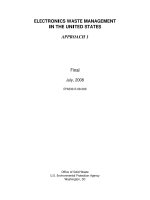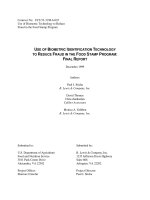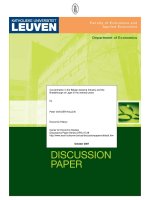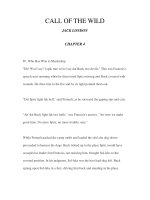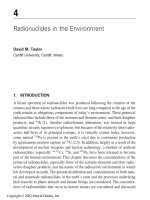Waste Treatment in the Food Processing Industry - Chapter 4 pptx
Bạn đang xem bản rút gọn của tài liệu. Xem và tải ngay bản đầy đủ của tài liệu tại đây (3.94 MB, 17 trang )
© 2006 by Taylor & Francis Group, LLC
4
Treatment of Palm Oil Wastewaters
Mohd Ali Hassan and Shahrakbah Yacob
University Putra Malaysia, Serdang, Malaysia
Yoshihito Shirai
Kyushu Institute of Technology, Kitakyushu, Japan
Yung-Tse Hung
Cleveland State University, Cleveland, Ohio, U.S.A.
4.1 INTRODUCTION
This chapter discusses the palm oil extraction process, wastewater treatment systems, and future
technologies and applications for the palm oil industry. Crude palm oil (CPO) is extracted from
contents originating from mesocarp and kernel are 20 and 4%, respectively. Palm oil is a
semisolid oil, rich in vitamins and several major fatty acids: oleic, palmitic, and linoleic. To
produce palm oil, a considerable amount of water is needed, which in turn generates a large
volume of wastewater. Palm oil mills and palm oil refineries are two main sources of palm oil
wastewater; however, the first is the larger source of pollution and effluent known as palm oil
mill effluent (POME). An estimated 30 million tons of palm oil mill effluent (POME) are
produced annually from more than 300 palm oil mills in Malaysia. Owing to the high pollution
load and environmental significance of POME, this chapter shall place emphasis on its treatment
system.
4.1.1 Production of Crude Palm Oil (CPO)
It is important to note that no chemicals are added in the extraction of oil from the oil palm fruits,
therefore, making all generated wastes nontoxic to the environment. The extraction of crude
palm oil involves mainly mechanical and heating processes, and is illustrated in several steps
Sterilization
To ensure the quality and the productivity of palm oil mill, the fresh fruit bunches (FFB) must be
processed within 24 hours of harvesting. Thus, most of the palm oil mills are located in close
101
the mesocarp of the fruitlets while palm kernel oil is obtained from the kernel (Fig. 4.1). The oil
below (Fig. 4.2).
© 2006 by Taylor & Francis Group, LLC
proximity to the oil palm plantation. During sterilization, the FFB is subjected to three cycles of
pressures (30, 35, and 40 psi) for a total holding time of 90 minutes. There are four objectives of
the FFB sterilization: (a) to remove external impurities, (b) to soften and loosen the fruitlets from
the bunches, (c) to detach the kernels from the shells, and, most importantly, (d) to deactivate the
enzymes responsible for the buildup of free fatty acids. The sterilization process acts as the first
contributor to the accumulation of POME in the form of sterilizer condensate.
Bunch Stripping
Upon completion of the sterilization, the “cooked” FFB will be subjected to mechanical
threshing to detach the fruitlets from the bunch. At this stage the loose fruitlets are transferred to
the next process while the empty fruit bunches (EFB) can be recycled to the plantation for
mulching or as organic fertilizer.
Digestion and Pressing
The digester consists of a cylindrical vessel equipped with stirrer and expeller arms mainly to
digest and press the fruitlets. Steam is introduced to facilitate the oil extraction from the digested
mesocarp. At the end of the process, oil and pressed cake comprising nuts and fiber are produced.
The extracted oil will then be purified and clarified in the next stage. At the same time the fiber
and nuts are separated in the depericarper column. The waste fiber is then burnt for energy
generation inside the boiler.
Oil Clarification and Purification
As the name of this process implies, the extracted oil is clarified and purified to produce CPO.
Dirt and other impurities are removed from the oil by centrifugation. Before the CPO is
transferred to the storage tank, it is subjected to high temperatures to reduce the moisture content
in the CPO. This is to control the rate of oil deterioration during storage prior to processing at the
palm oil refinery. The sludge, which is the byproduct of clarification and purification procedures,
is the main source of POME in terms of pollution strength and quantity.
Figure 4.1 (A) Cross-section cutting of oil palm fruit showing shell, mesocarp, and kernel sections; (B)
manual harvesting of fresh fruit bunches using sickle. (Courtesy of Malaysian Palm Oil Board.)
102 Hassan et al.
© 2006 by Taylor & Francis Group, LLC
Nut Cracking
At this point, the nuts from the digestion and pressing processes are polished (to remove
remnants of fiber) before being sent to the nut-cracking machine or ripple mill. The cracked
mixture of kernels and shells is then separated in a winnowing column using upwards suction
(hydrocyclone) and a clay bath. The third source of POME is the washing water of the
hydrocyclone. The kernel produced is then stored before being transferred to palm kernel
mill for oil extraction. Shell wastes will join the fiber at the boiler for steam and power
generation.
Figure 4.2 Flow diagram of crude palm oil extraction processes and sources of POME.
Treatment of Palm Oil Wastewaters 103
© 2006 by Taylor & Francis Group, LLC
4.1.2 Production of Refined Bleached Deodorized Palm Oil (RBDPO)
The refining of CPO employs physical/steam refining in which steam distillation is used to
separate free fatty acids under high temperature and vacuum (Fig. 4.3). It consists of two main
processes as follows.
Pretreatment
Before the actual refining process is carried out, the CPO is pretreated with phosphoric acid to
eliminate impurities such as gums and trace metals. A bleaching technique is then used to
remove phosphoric acid and its content under vacuum, followed by a filtration method. Solid
waste in the form of sludge is disposed and buried in a landfill.
Deodorization
At this stage, steam is introduced under a vacuum condition to strip the pretreated oil of vola-
tile free fatty acids, odoriferous compounds, and unstable pigments. The distillate for the
deodorization process will form the main source of palm oil refinery effluent (PORE). The
distillate has a free fatty acid content of approximately 80–90%. After the refining process, the
oil is known as refined, bleached and deodorized palm oil (RBDPO). Further process such as
fractionation of RBDPO will separate palm olein and stearin based on the different melting
points of each component.
Figure 4.3 Flow diagram of physical refining process of crude palm oil and source of PORE.
104 Hassan et al.
© 2006 by Taylor & Francis Group, LLC
4.2 PALM OIL MILL EFFLUENT (POME)
Palm oil mill effluent originates from two main processes: sterilization and clarification stages,
higher level of solid residues compared to the sterilizer condensate. Both contain some level of
unrecovered oils and fats. The final POME would of course include hydrocyclone washing and
cleaning up processes in the mill [1]. Approximately 1–1.5 tons of water are required to process
1 ton of FFB.
4.2.1 Properties of POME
Based on the process of oil extraction and the properties of FFB, POME is made up of about
95–96% water, 0.6–0.7% oil, and 4–5% total solid, including 2–4% suspended solids, which
are mainly debris from palm mesocarp [2]. No chemicals are added during the production of
palm oil; thus it is a nontoxic waste. Upon discharge from the mill, POME is in the form of a
highly concentrated dark brown colloidal slurry of water, oil, and fine cellulosic materials. Due
to the introduction of heat (from the sterilization stage) and vigorous mechanical processes, the
discharge temperature of POME is approximately 80–908C. The chemical properties of POME
vary widely and depend on the operation and quality control of individual mills [3]. The general
properties of POME are indicated in Table 4.1.
Apart from the organic composition, POME is also rich in mineral content, parti-
cularly phosphorus (18 mg/L), potassium (2270 mg/L), magnesium (615 mg/L) and calcium
(439 mg/L) [2]. Thus most of the dewatered POME dried sludge (the solid endproduct of the
POME treatment system) can be recycled or returned to the plantation as fertilizer.
4.2.2 Biological Treatment
Owing to its chemical properties, POME can be easily treated using a biological approach. With
high organic and mineral content, POME is a suitable environment in which microorganisms can
thrive. Hence, it could harbor a consortium of microorganisms that will consume or break down
the wastes or pollutants, turning them into harmless byproducts. In some cases, these byproducts
have high economic value and can be used as potential renewable sources or energy. In order to
achieve such a goal, a suitable mixed population of microorganisms must be introduced and the
Table 4.1 Chemical Properties of Palm Oil Mill Effluent (POME)
Chemical property Average Range
pH 4.2 3.4–5.2
BOD (mg/L) 25,000 10,250–43,750
COD (mg/L) 50,000 15,000–100,000
Oil and grease (mg/L) 6000 150–18,000
Ammoniacal nitrogen (mg/
L)
35 4–80
Total nitrogen (mg/L) 750 180–1400
Suspended solid (mg/L) 18,000 5000–54000
Total solid (mg/L) 40,000 11,500–78,000
Source: Refs. 3, 4.
Treatment of Palm Oil Wastewaters 105
as the condensate and clarification sludge, respectively (Fig. 4.2). The clarification sludge shows
© 2006 by Taylor & Francis Group, LLC
process should be optimized. Three biological processes are currently employed by the industry
as a series of anaerobic, facultative anaerobic, and aerobic treatments. However, the major
reduction of POME polluting strength — up to 95% of its original BOD — occurs in the first
stage, that is, during the anaerobic treatment [4].
The anaerobic process involves three main stages; hydrolytic, acidogenic, and
methanogenic. In the first stage, hydrolytic microorganisms secrete extracellular enzymes to
hydrolyze the complex organic complexes into simpler compounds such as triglycerides, fatty
acids, amino acids, and sugars. These compounds are then subjected to fermentative
microorganisms that are responsible for their conversion into short-chain volatile fatty acids —
mostly acetic, propionic, butyric acids, and alcohols. In the final stage, there are two separate
biological transformations: first, the conversion of acetic acid into methane and carbon dioxide
by methanogens; secondly, the conversion of propionic and butyric acids into acetic acid and
hydrogen gas before being consumed by the methanogens. The endproducts of the anaerobic
degradation are methane and carbon dioxide. Traces of hydrogen sulfide are also detected as the
result of the activity of sulfate-reducing bacteria in the anaerobic treatment. The biochemical
oxygen demand (BOD) at the first two stages remains at the same level as when it entered the
anaerobic treatment, because only the breakdown of the complex compounds to a simpler
mixture of organic materials has occurred. Only after the methanogenic stage will the BOD be
reduced significantly.
4.2.3 Wastewater Treatment Systems for POME
The choice of POME wastewater treatment systems is largely influenced by the cost of operation
and maintenance, availability of land, and location of the mill. The first factor plays a bigger role
in the selection of the treatment systems. In Malaysia, the final discharge of the treated POME
must follow the standards set by the Department of Environment (DOE) of Malaysia, which is
100 mg/L of BOD or less (Table 4.2) regardless of which treatment system is being utilized.
Pretreatment
Prior to the primary treatment, the mixed raw effluent (MRE, a mixture of wastewater from
sterilization, clarification, and other sources) will undergo a pretreatment process that includes
the removal of oil and grease, followed by a stabilization process. The excess oil and grease is
extracted from the oil recovery pit using an oil skimmer. In this process, steam is continuously
Table 4.2 Environmental Regulations for
Watercourse Discharge for Palm Oil Mill Effluent
(POME)
Parameters Level
BOD (mg/L) 100
Suspended solids (mg/L) 400
Oil and grease (mg/L) 50
Ammoniacal nitrogen (mg/L) 150
Total nitrogen (mg/L) 200
pH 5–9
Source: Ref. 5.
106 Hassan et al.
© 2006 by Taylor & Francis Group, LLC
supplied to the MRE to aid the separation between oil and liquid sludge. The recovered oil is
then reintroduced to the purification stage. The process will prevent excessive scum formation
during the primary treatment and increase oil production. The MRE is then pumped into the
cooling and mixing ponds for stabilization before primary treatment. No biological treatment
occurs in these ponds. However, sedimentation of abrasive particles such as sand will ensure that
all the pumping equipment is protected. The retention time of MRE in the cooling and mixing
ponds is between 1 and 2 days.
Ponding System
The ponding system is comprised of a series of anaerobic, facultative, and algae (aerobic) ponds.
These systems require less energy due to the absence of mechanical mixing, operation control, or
monitoring. Mixing is very limited and achieved through the bubbling of gases; generally this is
confined to anaerobic ponds and partly facultative ponds. On the other hand, the ponding system
requires a vast area to accommodate a series of ponds in order to achieve the desired
characteristics for discharge. For example, in the Serting Hilir Palm Oil Mill, the total length of
the wastewater treatment system is about 2 km, with each pond about the size of a soccer field
the earth. Hence, the ponding system is widely favored by the palm oil industry due to its
marginal cost.
In constructing the ponds, the depth is crucial for determining the type of biological
process. The length and width differ based on the availability of land. For anaerobic ponds,
the optimum depth ranges from 5 –7 m, while facultative anaerobic ponds are 1–1.5 m deep.
The effective hydraulic retention time (HRT) of anaerobic and facultative anaerobic systems
is 45 and 20 days, respectively. A shallower depth of approximately 0.5 – 1 m is required for
aerobic ponds, with an HRT of 14 days. The POME is pumped at a very low rate of 0.2 to
0.35 kg BOD/m
3
Á day of organic loading. In between the different stages of the ponding
system, no pumping is required, as the treated POME will flow using gravity or a sideways
tee-type subsurface draw-off system. Under these optimum conditions, the system is able to
meet the requirement of DOE. The number of ponds will depend on the production capacity
of each palm oil mill.
One problem faced by pond operators is the formation of scum, which occurs as the
the presence of oil and grease in the POME, which are not effectively removed during the
pretreatment stage. Another disadvantage of the ponding system is the accumulation of solid
inside the pond, lowering the effectiveness of the pond by reducing the volumetric capacity and
HRT. When this happens, the sludge may be removed by either using submersible pumps or
excavators. The removed sludge is dewatered and dried before being used as fertilizer. The
cleanup is normally carried out every 5 years or when the capacity of the pond is significantly
reduced.
Open Digester and Ponding Systems
The anaerobic digestion is carried out in the digester, then in the facultative anaerobic and algae
ponds. It has been shown that by using an open digester, a better reduction of BOD can be
achieved in a shorter time. Digesters are constructed of mild steel at various volumetric
capacities ranging from 600 up to 3600 m
3
. The treatment of treated POME from the digester
Treatment of Palm Oil Wastewaters 107
(Fig. 4.4). Only a clay lining of the ponds is needed, and they are constructed by excavating
bubbles rise to the surface, taking with them fine suspended solids (Fig. 4.5). This results from
sludge at the bottom of the ponds (Fig. 4.6). Eventually the sludge and scum will clump together
This system is a combination of an open digester tank and a series of ponding systems (Fig. 4.7).
© 2006 by Taylor & Francis Group, LLC
will start at the facultative ponds, followed by the algae ponds. A description of the ponding
systems is outlined in the previous section “Pretreatment.”
The HRT of the digester is only 20–25 days and has a higher organic loading of
0.8–1.0 BOD kg/m
3
Á day compared to anaerobic ponds. With minimal financial input from the
operators, no mechanical mixing equipment is installed in the digesters. Using the same
principle as anaerobic ponds, mixing of POME is achieved via bubbling of biogas. Occasionally,
the mixing is also achieved when the digester is being recharged with fresh POME. The treated
POME is then overflowed into the ponding system for further treatment.
Although the digester system has been proven to be superior to anaerobic ponds, it also has
similar problems of scum formation and solid sludge accumulation. Another serious problem is
Figure 4.4 A series of ponds for POME treatment occupying a large land area. (Courtesy of Felda Palm
Industries.)
108 Hassan et al.
© 2006 by Taylor & Francis Group, LLC
the corrosion of the steel structures due to long exposure to hydrogen sulfide. Incidents such as
burst and collapsed digesters have been recorded. Accumulated solids could be easily removed
using the sludge pipe located at the bottom of the digester. The dewatered and dried sludge can
then be disposed for land application.
Extended Aeration
To complement the previous systems, mechanical surface aerators can be introduced at the
aerators are normally installed at the end of the ponding system before discharge. However, this
happens only where land area is a constraint and does not permit extensive wastewater
treatment. Otherwise, aerators must be provided to meet DOE regulations.
4.3 PALM OIL REFINERY EFFLUENT (PORE)
Following the production of CPO from the palm oil mill, the CPO is then subjected to further
refining before it can be categorized as edible oil. Even after the clarification and purification
processes, there are still large amounts of impurities such as gums, pigments, trace of metals, and
soluble fats that cause unpleasant taste, odor, and color. There are three common types of
operation in the palm oil refineries: (a) physical refining and dry fractionation, (b) physical
refining and detergent fractionation, and (c) physical and chemical refining with dry/detergent
fractionation [6].
Figure 4.5 Active bubbling of gases leading to the formation of scum.
Treatment of Palm Oil Wastewaters 109
aerobic ponds (Fig. 4.8). This effectively reduces the BOD through aerobic processes. The
© 2006 by Taylor & Francis Group, LLC
4.3.1 Chemical Properties of PORE
The main sources of PORE are water from the deodorization process and cleaning operations
Figure 4.6 Formation of islets of sludge in the middle of the pond. (Courtesy of Felda Palm Industries.)
Figure 4.7 A series of 3600 m
3
open digesters for POME treatment. (Courtesy of Felda Palm
Industries.)
110 Hassan et al.
within the mill (Fig. 4.3). The characteristics of PORE are very much dependent on the type of
process employed. The main chemical properties of PORE are as described in Table 4.3.
© 2006 by Taylor & Francis Group, LLC
In comparison with POME, PORE is less polluting. This is largely due to the absence of oil
and grease, and its low organic load. From Table 4.3, it is obvious why most of the palm oil
refineries in Malaysia have adopted physical refining and dry fractionation to produce edible oil.
Not only does the system reduce the effluent problem, but higher yield and oil purity with lower
operating costs are obtained.
Figure 4.8 An aerator system installed to accelerate BOD reduction at the aerobic pond. (Courtesy of
Malaysian Palm Oil Board.)
Table 4.3 Chemical Properties of Palm Oil Refinery Effluent (PORE) Based on Different Operations
Type of refinery processes
Chemical properties
Physical refining and
dry fractionation
Physical refining and
detergent fractionation
Physical and chemical
refining with dry/
detergent fractionation
Temperature (8C) 35 42 57
pH 5.3 4.9 3.0
BOD (mg/L) 530 2640 4180
COD (mg/L) 890 5730 7700
Total solids (mg/L) 330 1170 2070
Suspended solids (mg/L) 50 12 6
Phosphorus (mg/L) 4 1 12
Total fatty matter (mg/L) 220 1580 3550
Source: Ref. 3.
Treatment of Palm Oil Wastewaters 111
© 2006 by Taylor & Francis Group, LLC
4.3.2 Wastewater Treatment Systems for PORE
Unlike POME wastewater treatment systems, the PORE system is more systematic and
predictable. Most PORE systems involve biological processes, with some using physical and
chemical methods such as sedimentation, dissolved air flotation after coagulation and
flocculation using lime, alum and polyelectrolytes [8].
Pretreatment of PORE
The first step in ensuring satisfactory performance of a PORE treatment plant is to remove oil
and fat from the MRE. The separation is carried out using several methods such as fat traps,
tilted-plate separators, and dissolved flotation units. Beside physical separations, the addition of
chemical flocculants and coagulants also helps in reducing the total fatty matter and other
suspended solids. Before the commencement of the biological treatment, the pH of the PORE
is adjusted to the desired level as pH plays an important role in the optimum biodegradation
of PORE.
Activated Sludge System
Many palm oil refineries use activated sludge systems to treat PORE. This is because of land
constraints (for ponding systems) and effective removal of BOD in a short HRT [6]. This system
can be very effective if the level of total fatty matter is kept low after the pretreatment stage. The
presence of fatty matter in the activated sludge systems will contribute not only higher BOD but
the formation of scum. This leads to poor performance of the system.
The treatment is carried out by bringing PORE into contact with a mixed population of
aerobic microorganisms in the controlled environment of the activated sludge system. In this
process, oxygen is supplied via aeration or vigorous agitation for the oxidation of organic wastes
to carbon dioxide. After the treatment, the suspended biomass is separated in the clarifier. The
biomass is reintroduced back into the activated sludge systems as “return activated sludge.” This
is to ensure the density of microorganisms is maintained at an optimum level for maximum
removal of BOD. The supernatant from the clarifier can then be safely discharged into the
watercourse. The HRT of PORE and cell residence time are 1–2 days and 3–10 days,
respectively. Using this system, a final BOD and suspended solids of 20 and 30 mg/L,
respectively, can be obtained with 1500–2000 mg/L of mixed liquor suspended solids. Apart
from the energy requirement to operate the treatment facilities, additional nutrients are normally
added to the effluent. This is because the effluent from the palm oil refinery is low in nitrogen
content, which is essential for the growth of aerobic micro-organisms. A ratio of BOD : N of
100 : 5 is kept constant throughout the process.
4.4 POTENTIAL TECHNOLOGIES AND COMMERCIAL APPLICATIONS
OF PALM OIL WASTES
4.4.1 POME Treatment
Evaporation Technology
In one study, a 200 L single-effect evaporator was constructed to test the evaporation technique
in POME treatment [8]. It used the principle of rapid heating to vaporize water at 600 mmHg and
808C using a plate heat exchanger. Staggered feeding of fresh POME was introduced into the
evaporator when the liquor dropped by half of the initial volume. The feeding was carried out
until the accumulated solid sludge reached the pre-set level of 30%. The solid was then
112 Hassan et al.
© 2006 by Taylor & Francis Group, LLC
discharged before the new cycle began. The single-effect evaporator was able to recover 85% of
water from POME with a good quality distillate of 20 mg/L BOD. The distillate could be
recycled as process water or feedwater for the boiler in the mill. Even though the system
promises a significant reduction of liquid waste (and thus less dependence on vast land area for
ponding systems), the energy required for heating may impose financial constraints for the mill
operator. Moreover, the mill may have to make a big investment in equipment, skilled operators,
and maintenance. Further studies are being carried out to produce cost-effective systems such as
utilizing excess organic biomass from the mill as an energy source.
High-Technology Bioreactor Design
There have been numerous studies to optimize the anaerobic treatment of POME using vari-
ous designs of bioreactor. Laboratory-scale studies have been carried out to evaluate the
effectiveness of anaerobic filters (AF) and a fluidized-bed reactor (FBR) in treating POME [9].
About 90% of the fed COD was effectively removed by both reactor systems. However, when
the COD loading was increased, a significant reduction in terms of COD removal was recorded
in the FBR system, while clogging of the filter was evident in the AF reactor. A higher COD
removal efficiency was reported [10] when using a modified anaerobic baffled reactor (MABR).
The system also demonstrated a short retention time of 3 days. Despite the good potential of the
bioreactor systems for POME treatment, none has been implemented at a larger scale.
Power Generation: Closed Digester
The composition of biogas emitted from an open digester tank and the lagoon was lower than
that reported for laboratory studies [2]. The biogas composition was 40% methane and 60%
carbon dioxide for the open digester tank, and 55% methane and 45% carbon dioxide in
anaerobic lagoons. In terms of energy value, it is comparable to commercially available gas fuels
as shown in Table 4.4. The potential energy that could be generated from 1 m
3
of biogas is
1.8 kWh [11].
A closed digesting system was tested to improve the anaerobic digestion of POME,
leading to the production of biogas. Using the same design of open digester, a fixed or floating
cover is included, equipped with the other facilities such as gas collector, safety valves, and
monitoring facilities.
Compost
Based on our research, dewatered POME sludge can be composted with domestic wastes and
bulking agents such as shredded wood and sawdust. A modified composter from a cement mixer
with insulated drum was used as a reactor to run the composting process. Experimental
Table 4.4 Comparisons Between Methane Derived from Anaerobic Digestion of POME and
Other Gas Fuels
Chemical properties Methane Natural gas Propane
Gross calorific value (kcal/kg) 4740–6150 907 24,000
Specific gravity 0.847–1.002 0.584 1.5
Ignition temperature (8C) 650–750 650 –750 450–500
Inflammable limits (%) 7.5–21.0 5–15 2–10
Combustion air required (m
3
/m
3
) 9.6 9.6 13.8
Source: Ref. 11.
Treatment of Palm Oil Wastewaters 113
© 2006 by Taylor & Francis Group, LLC
parameters such as aeration, pH, temperature, C/N ratio, and moisture content were controlled
and monitored during the fermentation phase of the composting process. It took about 40 days to
completely convert the POME sludge into compost via the solid substrate fermentation process
with mixed microbial inoculum. The carbon content decreased towards the end of the
composting process, which resulted in a decrease of the C/N ratio from 30 to 20. The low
C/N ratio of the final compost product was very important as an indicator of maturity. The
characteristics of the final compost products for POME sludge were similar to commercial
composts and complied with US Environmental Protection Agency (EPA) standards, especially
in heavy metal content and total coliforms. Planting out tests with leafy vegetables showed
satisfactory performance [12].
Organic Acids
Two-stage fermentation was carried out in a study where POME was used as substrate for
volatile fatty acids (VFA) production by continuous anaerobic treatment using a locally fabri-
cated 50 L continuous stirred tank reactor (CSTR). The highest VFA obtained was at 15 g/Lat
pH 6.5, 308C, 100 rpm, sludge to POME ratio 1 : 1, HRT 4 days, without sludge recycle. The
highest BOD removal corresponded with the high production of organic acids. The organic acids
produced from POME were then recovered and purified using acidification and evaporation
techniques. A clarified concentrated VFA comprised of 45 g/L acetic, 20 g/L propionic and
22 g/L butyric acids were obtained with a recovery yield of 76% [13].
Production of Polyhydroxyalkanoates
The organic acids from treated POME can be used to biologically synthesize polyhydroxyalk-
anoates (PHA), a bacterial bioplastic. The concentrated organic acids obtained were used in a
fed-batch culture of Alcaligenes eutrophus for the production of PHA. About 45% PHA content
in the dry cells could be obtained, corresponding to a yield of 0.32 from acetic acid. The overall
volumetric productivity of PHA is estimated at 0.09 g PHA/L hour. This indicates that the
application of a high-density cell culture to produce bioplastic from POME can be achieved [14].
Biological Hydrogen
Another potential application of POME as a renewable resource of energy is the production of
biological hydrogen via a fermentation process. The main purpose of producing biological
hydrogen is to offer an alternative source of energy to fossil fuels. The major advantage of biolog-
ical hydrogen is the lack of polluting emission since the utilization of hydrogen, either via
combustion or fuel cells, results in pure water [15]. Currently, two proposed systems produce
biological hydrogen using photoheterotrophic and heterotrophic bacteria. However, the latter is
most suitable for POME due to limited light penetration caused by the sludge particles as
experienced during the production of PHA by phototrophic Rhodobacter sphaeroides [16].
Moreover, it would be costly to construct and maintain a photobioreactor at a commercial-scale
operation.
In the anaerobic degradation of POME, complex organic matter is converted into a
mixture of methane and carbon dioxide in a network of syntrophic bacteria. Prior to this,
fermentative and acetogenic bacteria first convert organic matter into a mixture of VFA and
hydrogen before being consumed by methanogenic bacteria. Based on the metabolic activities of
these microorganisms in POME degradation, a system combining the organic acids and
biological hydrogen production is suggested. However, the utilization of biological hydrogen
from POME is still at the planning stage. Major development in terms of selection of suitable
microorganisms and optimization of process conditions is required for cost-effective production
114 Hassan et al.
© 2006 by Taylor & Francis Group, LLC
of hydrogen. Nevertheless, this technology promises a means to conserve the environment by
generating clean energy.
4.4.2 PORE Treatment
Sequential Batch Reactor System
A new technology using the sequential batch reactor (SBR) technique has been shown to provide
an effective treatment of PORE [7] as shown in Figure 4.9. Among the advantages of SBR over
the conventional activated sludge are an automated control system, more versatility, stability,
and the ability to handle high fluctuations in organic loading. A consistent output of BOD below
50 mg/L was observed. With this system, the hydraulic retention time and solid sludge content
could be controlled, thus eliminating the need for clarifier and sludge recycling facilities.
4.5 FUTURE TRENDS
From the preceding section, several potential and emerging technologies for POME wastewater
to combine the existing wastewater treatment system with the production of appropriate
bioproducts, towards zero discharge for the palm oil industry [17]. In anaerobic treatment,
methanogenic activity will be suppressed or inhibited in order to extract the organic acids
produced. This, in turn, shall lower the greenhouse gases (methane and carbon dioxide)
emissions from the anaerobic digestion, thus reducing the effects of global warming. Further
separation and purification processes are needed before organic acids can be utilized as a
Figure 4.9 A pilot plant sequential bioreactor system tested for POME treatment. (Courtesy of
Malaysian Palm Oil Board.)
Treatment of Palm Oil Wastewaters 115
treatment system can be integrated into the palm oil mill operation (Fig. 4.10). The strategy is
© 2006 by Taylor & Francis Group, LLC
substrate for PHA-producing microorganisms. The solid wastes (sludges) generated from the
wastewater treatment system will be used as a mixture with EFB to form biocompost.
Wastes generated from the palm oil mill contain a high percentage of degradable organic
material and can be converted into value-added products and chemicals. It is expected that
changes in the technologies in POME treatment could lead to a substantial reduction in terms of
waste discharged. On the other hand, the palm oil industry will experience a sustainable growth by
addressing the excessive pollution issue through development of biowastes as alternative sources
of renewable energy and valued chemicals. This in turn shall generate additional revenue for the
industry. Finally, better-integrated waste management is associated with other environmental
benefits such as reduction of surface waterbody and groundwater contamination, less waste of
land and resources, lower air pollution, and a reduction of accelerating climate changes.
REFERENCES
1. Agamuthu, P. Palm oil mill effluent — treatment and utilization. In Waste Treatment Plant; Sastry,
C.A., Hashim, M.A., Agamuthu, P., Eds.; Narosa Publishing House: New Delhi, India, 1995; 338–360.
Figure 4.10 Proposed integrated palm oil production and POME wastewater treatment system (from
Ref. 17).
116 Hassan et al.
© 2006 by Taylor & Francis Group, LLC
2. Ma, A.N. Treatment of palm oil mill effluent. In Oil Palm and the Environment — A Malaysian
Perspective; Singh, G., Lim, K.H., Leng, T., David, L.K., Eds.; Malaysian Oil Palm Growers Council:
Selangor, Malaysia, 1999; 113–126.
3. Basiron, Y.; Darus, A. The oil palm industry — from pollution to zero waste. The Planter 1995, 72
(840), 141–165.
4. Ma, A.N. Environment management for the palm oil industry. Palm Oil Develop. 1999, 30, 1 –10.
5. Md. Noor, M. Environmental legislation: Environmental quality act, 1974. In Oil Palm and the
Environment — A Malaysian Perspective; Singh, G., Lim, K.H., Leng, T., David, L.K., Eds.;
Malaysian Oil Palm Growers Council: Selangor, Malaysia, 1999; 261 –264.
6. Ma, A.N. Treatment of palm oil refinery effluent. In Oil Palm and the Environment — A Malaysian
Perspective; Singh, G., Lim, K.H., Leng, T., David, L.K., Eds.; Malaysian Oil Palm Growers Council:
Selangor, Malaysia, 1999; 127–136.
7. Sastry, C.A. Waste treatment case studies. In Waste Treatment Plant; Sastry, C.A., Hashim, M.A.,
Agamuthu, P., Eds.; Narosa Publishing House: New Delhi, 1995; 361–379.
8. Ma, A.N. Evaporation technology for pollution abatement in palm oil mills. In Proceedings of the
National Seminar on Palm Oil Milling, Refining Technology and Quality; Chang, A.K.C., Ed.;
PORIM: Selangor, Malaysia, 1997; 167–171.
9. Borja, R.; Banks, C.J. Comparison of an anaerobic filter and an anaerobic fluidized bed reactor
treating palm oil mill effluent. Process Biochem. 1995, 30 (6), 511–521.
10. Faisal, M; Unno, H. Kinetic analysis of palm oil mill wastewater treatment by a modified anaerobic
baffled reactor. Biochem. Eng. J. 2001, 9, 25–31.
11. Ma, A.N.; Toh, T.S.; Chua, N.S. Renewable energy from oil palm industry. In Oil Palm and the
Environment — A Malaysian Perspective; Singh, G., Lim, K.H., Leng, T., David, L.K., Eds.;
Malaysian Oil Palm Growers Council: Selangor, Malaysia, 1999; 253 –260.
12. Abdul Rahman, A.R.; Baharum, Z.; Hassan, M.A.; Idris, A. Bioreactor composting of selected
organic sludges. Proceedings of the 13th National Biotechnology Seminar, Penang, Malaysia, 2001.
13. Noraini, A.R.; Hassan, M.A.; Shirai, Y.; Karim, M.I.A. Production of organic acids from palm oil mill
effluent during continuous anaerobic treatment. Asia-Pac. J. Mol. Biol. 1999, 7 (2), 179–184.
14. Hassan, M.A.; Shirai, Y.; Umeki, H.; Yamazumi, H.; Jin, S.; Yamamoto, S.; Abdul Karim, M.I.;
Nakanishi, K.; Hashimoto, K. Acetic acid separation from anaerobically treated palm oil mill effluent
by ion exchange resin for the production of polyhydroxyalkanoate by Alcaligenes eutrophus. Biosci.
Biotech. Biochem. 1997, 61 (9), 1465–1468.
15. Claassen, P.A.M; van Lier, J.B.; Lopez Contreras, A.M.; van Niel, E.W.J.; Sijtsma, L.; Stams, A.J.M.;
de Vries, S.S.; Weusthuis, R.A. Utilization of biomass for the supply of energy carrier. Appl.
Microbiol. Biot. 1999, 52, 741–755.
16. Hassan, M.A.; Shirai, Y.; Kusubayashi, N.; Abdul Karim, M.I.; Nakanishi, K.; Hashimoto, K. The
production of polyhydroxyalkanoate from anaerobically treated palm oil mill effluent by Rhodobacter
sphaeroides. J. Ferment. Bioeng. 1997, 83 (3
), 485–488.
17. Hassan, M.A.; Nawata, O.; Shirai, Y.; Noraini, A.R.; Yee, P.L.; Karim, M.I.A. A proposal for zero
emission from palm oil industry incorporating the production of polyhydroxyalkanoates from palm
oil mill effluent. J. Chem. Eng. Jpn. 2002, 35 (1), 9–14.
18. Malaysia Palm Oil Board. The processing sector, In Oil Palm Industry in Malaysia; Salleh, M., Ed.;
Malaysia Palm Oil Board: Selangor, Malaysia, 2000; 10 –17.
Treatment of Palm Oil Wastewaters 117

